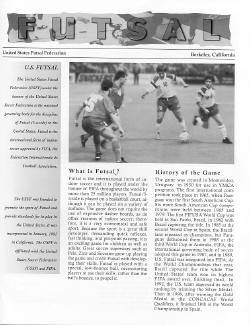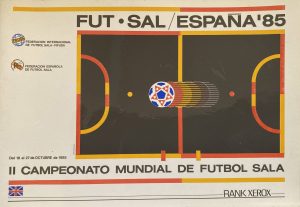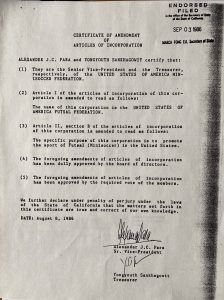The origin of Futsal (Five-a-Side Soccer) can be traced back to Montevideo, Uruguay, in 1930 when Juan Carlos Ceriani devised a five-a-side version of soccer  for youth competion in YMCAs. The game is played on basketball-sized courts, both indoors and out without the use of sidewalls.
for youth competion in YMCAs. The game is played on basketball-sized courts, both indoors and out without the use of sidewalls.
The game is frequently referred to as Five-A-Side or Mini-soccer. Once Ceriani got the ball rolling, Futsal gained rapid popularity throughout South America, particularly in Brazil. The skill developed in this game is visible in the world-famous style the Brazilians display outdoors on the full-sized field. Pele, Zico, Socrates, Bebeto and other Brazilian superstars developed their skill playing Futsal. While Brazil continues to be the Futsal hub of the world, the game is now played, under the auspices of FIFA, all over the world, from Europe to North and Central America and the Caribbean, South America, Africa, and Asia and Oceania.
How U.S Futsal began
The first international competition took place in 1965, when Paraguay won the first South American Cup. Six more South American Cups were held through 1979, with Brazil winning all of them. Brazil continued its dominance with a victory in the first Pan American Cup in 1980 and won it again the next time it was played in 1984. A U.S. team took part in the 1984 cup, but finished out of the running.
U.S. Futsal was founded in 1981 and incorporated in January, 1983. Osvaldo Garcia was it’s first president. The game is referred to as Minisoccer, five-a-side soccer, Futbol Sala or Futebol de Salao, but it is also widly refereed by it trademark name, Futsal. The current U.S. Futsal president is Alex J.C. Para.
The first Futsal World Championship conducted under the auspices of FIFUSA (before its members integrated into FIFA in 1989) was held in Sao Paulo, Brazil, in 1982, with Brazil finishing in first place. The Brazilians repeated as champions at the second World Championship in 1985 in Spain, but lost in the third World Championship in 1988 in Australia to Paraguay. FIFA took over direct sponsorship of the event in 1989 in Holland and 1992 in Hong Kong. Brazil won both times. The U.S. Futsal (Indoor Team), finished third in 1989 and second in 1992 at the FIFA Five-a-Side World Championship. The highest showing by any team from the United States in a FIFA tournament until the U.S. Womens team won the gold medal in China for outdoor soccer. The Third FIFA World Championship was held November 24 through December 11, 1996, in Spain and for the first time FIFA names it the FIFA Futsal World Championship. The Fourth FIFA Futsal World Championship was held in Guatemala between November 18 to December 4th, 2000. The fifth Futsal World Championship was held in Taipei in December 2004.
The first international Futsal match played by the U.S. Futsal National Team was in May 1984 in Nanaimo, Canada, and the United States won 6-5. The first international Futsal match in the United States was held in December, 1985, at Sonoma State University in Rohnert Park, California. The U.S. select team, defeated Australia, 9-5.
U.S. Futsal has conducted a National Championship each year since 1985. Futsal is establishing itself at the youth level in the U.S. The Boys and Girls Clubs of America took a strong interest after the Columbia Park Club in San Francisco asked U.S. Futsal to give a demonstration. The national organization adopted the sport, and it is now played at about 1,100 Boys and Girls Clubs throughout the U.S. The American Youth Soccer Organization (AYSO) also plays the sport in a close working relationship with U.S. Futsal since 1988.
The U.S. Youth Soccer Association (USYSA) and U.S. Futsal signed an agreement in August of 1995 and in 1999, to promote futsal in all their National State Association as their game of choice for indoor soccer under the auspices of U.S. Futsal.
History of the Name FUTSAL
The term FUTSAL is now the international term used for the game, it was first created by Alexander Para, for then the U.S. Minisoccer Federation (USMF).
 Mr. Para knowing that having the term “soccer ” in its name made it hard to obtain gym from school since most schools thought that a soccer ball in a gym would damage their facilities. He looked for a word like “NIKE” or KODAK, that would describe the sport and be able to be used in any language of the world. While in Spain in early 1985 he noticed that the Spanish like the Brazilians called the sport with similar names. The Portuguese or Spanish word for “soccer”– FUTebol or FUTbol, and for “indoor” — SALon or SALa. At the FIFUSA World Championship the organizers used the term FUT- SAL in their program. Upon seeing this Mr. Para decided to merge the two world and came up with the world FUTSAL.
Mr. Para knowing that having the term “soccer ” in its name made it hard to obtain gym from school since most schools thought that a soccer ball in a gym would damage their facilities. He looked for a word like “NIKE” or KODAK, that would describe the sport and be able to be used in any language of the world. While in Spain in early 1985 he noticed that the Spanish like the Brazilians called the sport with similar names. The Portuguese or Spanish word for “soccer”– FUTebol or FUTbol, and for “indoor” — SALon or SALa. At the FIFUSA World Championship the organizers used the term FUT- SAL in their program. Upon seeing this Mr. Para decided to merge the two world and came up with the world FUTSAL.
Upon his return from the World Championship Mr. Para proposed to the board of USMF  that it change its name to include the new word “FUTSAL”, for those that where skeptic he mentioned that the new word included the initials “fUtSAl” (USA). The new word was adopted by U.S. Minisoccer Federation in 1986 when it changed it’s California Corporate name to United States Futsal Federation. It also had the term “FUTSAL” trademarked in Patent and Trademark Office in the United States in 1989 (PTO Serial # 73832190, Registration # 1645572). In 1989 at the meeting of integration between FIFA and FIFUFA (the old governing body of salon futbol), Mr. Para proposed that the new name that FIFA had planned for the sport in the second “FIFA Five-a-Side World Championship” to be held in Hong Kong in 1992 be changed for the 3 rd . World Championship in Spain to FUTSAL. It was Mr. Para view that the new term “Five-a-Side” would change depending in which language you were speaking and that a new game should have a name that would not change. Dr. Havelange, then President of FIFA, accepted the idea and had the term incorporated into Article 27, that states. “The committee for soccer that is played in reduced areas called Salon Soccer or Five-a-Side, shall from now on be called FUTSAL. All FIFA Futsal World Championships since 1996 have used the name.
that it change its name to include the new word “FUTSAL”, for those that where skeptic he mentioned that the new word included the initials “fUtSAl” (USA). The new word was adopted by U.S. Minisoccer Federation in 1986 when it changed it’s California Corporate name to United States Futsal Federation. It also had the term “FUTSAL” trademarked in Patent and Trademark Office in the United States in 1989 (PTO Serial # 73832190, Registration # 1645572). In 1989 at the meeting of integration between FIFA and FIFUFA (the old governing body of salon futbol), Mr. Para proposed that the new name that FIFA had planned for the sport in the second “FIFA Five-a-Side World Championship” to be held in Hong Kong in 1992 be changed for the 3 rd . World Championship in Spain to FUTSAL. It was Mr. Para view that the new term “Five-a-Side” would change depending in which language you were speaking and that a new game should have a name that would not change. Dr. Havelange, then President of FIFA, accepted the idea and had the term incorporated into Article 27, that states. “The committee for soccer that is played in reduced areas called Salon Soccer or Five-a-Side, shall from now on be called FUTSAL. All FIFA Futsal World Championships since 1996 have used the name.
